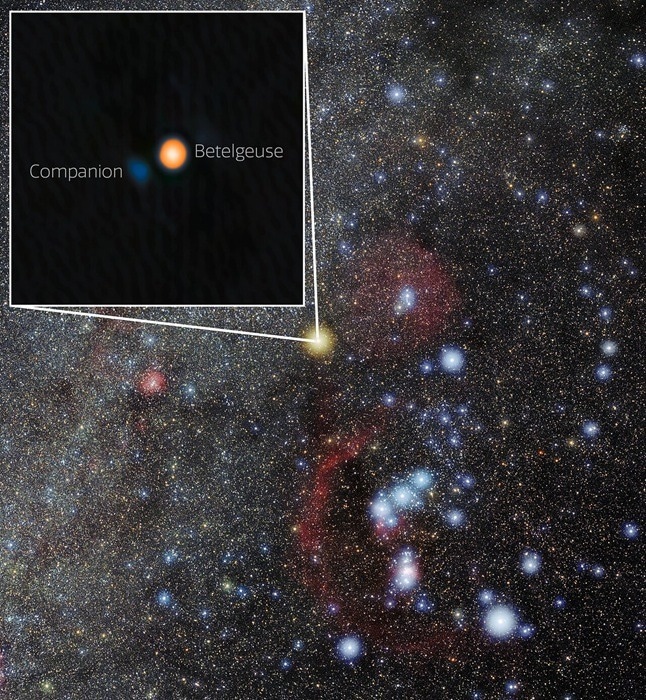Astronomers have used the NASA and U.S. National Science Foundation-funded “Alopeke instrument on Gemini North,” one half of the International Gemini Observatory, which is partially funded by the NSF and run by NSF NOIRLab, to find a companion star in an exceptionally tight orbit around Betelgeuse, according to a study published in The Astrophysical Journal Letters.

Using the NASA-NSF-funded ‘Alopeke instrument on the Gemini North telescope, one half of the International Gemini Observatory, partly funded by the U.S. National Science Foundation (NSF) and operated by NSF NOIRLab, astronomers have discovered a companion star in an incredibly tight orbit around Betelgeuse. This discovery answers the millennia-old question of why this famous star experiences a roughly six-year-long periodic change in its brightness, and provides insight into the physical mechanisms behind other variable red supergiants. The companion star appears blue here because, based on the team’s analysis, it is likely an A- or B-type star, both of which are blue-white due to their high temperatures. Image Credit: International Gemini Observatory/NOIRLab/NSF/AURA
This finding sheds light on the fundamental processes underlying other variable red supergiants and resolves the long-standing enigma of the star's fluctuating brightness.
Betelgeuse is the closest red supergiant to Earth and ranks among the brightest stars in the night sky, with a radius roughly 700 times that of the Sun. It is late in its life, even though it is only ten million years old - a relatively young age by astronomical standards.
For thousands of years, people have used the unaided eye to observe Betelgeuse, a star in the shoulder of the constellation Orion, and have noted how its brightness varies over time. It was determined by astronomers that Betelgeuse has a 400-day main period of variability and a six-year secondary period.
The brightness of Betelgeuse had a sharp decline in 2019 and 2020, an event known as the “Great Dimming.” Scientists were able to identify that the dimming was actually produced by a vast cloud of dust blasted by Betelgeuse, despite the fact that the occurrence gave some people the impression that a supernova death was imminent.
The Great Dimming Mystery was solved, but the incident rekindled interest in researching Betelgeuse, resulting in fresh analysis of archive data on the star. One analysis led scientists to propose that Betelgeuse's six-year variability is caused by the presence of a companion star. However, when the Hubble Space Telescope and the Chandra X-Ray Observatory searched for this companion, no results were obtained.
The companion star was discovered for the first time by a team of astrophysicists led by Steve Howell, senior research scientist at NASA Ames Research Center and main author of the study announcing the finding. They observed Betelgeuse with a speckle imager called ‘Alopeke.’
Alopeke, which means ‘fox’ in Hawaiian, is supported by the NASA-NSF Exoplanet Observational Research Program (NN-EXPLORE) and is installed on the Gemini North telescope, one half of the International Gemini Observatory, which is partially financed by the National Science Foundation and maintained by NSF NOIRLab.
Speckle imaging is an astronomical imaging technology that employs extremely short exposure durations to eliminate distortions induced by the Earth's atmosphere. This technique allows for high resolution, which, combined with the light-collecting power of Gemini North's 8.1-meter mirror, allowed Betelgeuse's faint companion to be directly detected.
Howell and his colleagues were able to ascertain the companion star's properties by analyzing its light. They discovered that it has an estimated mass of about 1.5 times that of the Sun, is six magnitudes fainter than Betelgeuse in the optical wavelength range, and looks to be an A- or B-type pre-main-sequence star, which is a hot, young, blue-white star that has not yet started burning hydrogen in its core.
At roughly four times the distance between Earth and the Sun, the companion is comparatively close to the surface of Betelgeuse. This finding marks the first detection of a close-in stellar companion circling a supergiant star. Even more amazing is the fact that the companion circles deep into Betelgeuse’s outer extended atmosphere, demonstrating ‘Alopeke’’s extraordinary resolving powers.
Gemini North’s ability to obtain high angular resolutions and sharp contrasts allowed the companion of Betelgeuse to be directly detected.
Steve Howell, Study Lead Author and Senior Research Scientist, Ames Research Center, NASA
Additionally, he clarifies that ‘Alopeke’ accomplished something that no other telescope had previously done.
He added, “Papers that predicted Betelgeuse’s companion believed that no one would likely ever be able to image it.”
This discovery sheds light on this red supergiant's life and impending demise. Betelgeuse and its companion star were probably born at the same time. However, the companion star's existence will be cut short when powerful tidal forces lead it to spiral into Betelgeuse and die, which astronomers predict will happen within the next 10,000 years.
The research also explains why comparable red supergiant stars may experience periodic brightness variations over many years. Howell expresses his desire for additional research in this area.
He added, “This detection was at the very extremes of what can be accomplished with Gemini in terms of high-angular resolution imaging, and it worked. This now opens the door for other observational pursuits of a similar nature.”
Martin Still, NSF program director for the International Gemini Observatory added, “The speckle capabilities provided by the International Gemini Observatory continue to be a spectacular tool, open to all astronomers for a wide range of astronomy applications. Delivering the solution to the Betelgeuse problem that has stood for hundreds of years will stand as an evocative highlight achievement.”
When Betelgeuse’s stellar companion returns to its farthest separation from Betelgeuse in November 2027, it will be easier to detect, providing another opportunity to examine it. To further restrict the companion’s nature, Howell and his team anticipate Betelgeuse observations both prior to and during this event.